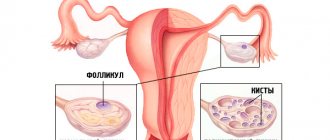The success rate after the first IVF attempt is 35–42%. The approximate probability is 1 in 3, but every woman hopes that she will be the chosen one who can bear a healthy child the first time.
Therefore, at the slightest suspicion of pathology, the expectant mother will immediately begin to get nervous and worry, asking herself and the doctor over and over again whether the pregnancy is proceeding normally. The slightest changes in well-being can tell a lot about the status of pregnancy after IVF.
In this article we want to talk about the discharge that appears after embryo transfer. Should you worry about them? Are they talking about some kind of pathology? Can they be avoided?
Normal discharge during pregnancy after IVF
Do not be afraid of secretions coming from the vagina. Normally, the endocrine glands constantly produce mucus, regardless of whether a woman is carrying a child under her heart or not.
The functions of the secret are:
- protecting the mucous membrane of the genital organs from drying out;
- creating the required level of acid-base balance;
- maintaining a stable amount of positive microflora.
Characteristics of physiological secretions:
| Color | Transparent |
| Smell | Odorless (the norm also allows for a barely noticeable sour tint) |
| Appearance | Viscous, without clots |
| Volume | No more than 1 teaspoon per day |
| Date of appearance | Stable |
| Peculiarities | There is no painful sensation during discharge; after drying they look like a starch stain |
Preparation on the eve of hormonal stimulation
Today, there are several protocols that have different schemes, durations, drugs and effectiveness. The choice of one or another protocol should be made by a reproductologist who examines and treats infertile couples. Only on the basis of the examination results obtained, the doctor determines the cause of infertility and, based on it, selects a suitable protocol.
IVF: ovarian stimulation is based on the fact that, under the influence of hormonal agents, the production of hormones produced by the body is suppressed, and in return for this, ovulation and maturation of germ cells are artificially stimulated. You can't do this without hormonal drugs. Based on the tests and examination results, taking into account the woman’s age and physical health, the doctor decides on the choice of one or another fertilization protocol.
Stimulation of ovulation begins at the beginning of the menstrual cycle (on the 3rd – 4th day of the cycle), as a result of which the ovaries actively work and several follicles with eggs mature at once. The presence of many eggs not only increases the chance of conception, but also makes it possible, in the event of an unsuccessful IVF protocol, to carry out a second one, but without ovulation stimulation, and first freeze the biological material.
IVF stimulation often ends with the puncture of oocytes, followed by fertilization of the eggs in the laboratory, their cultivation and replantation into the uterus.
What discharge should you be wary of?
The expectant mother should tell the doctor about any changes in her health, including discharge, because it can be one of the symptoms of more serious diseases.
If you notice one of the following in yourself, immediately contact a gynecologist or reproductive specialist.
Greenish-yellow discharge with odor
Characteristics of pathological discharge:
| Cause | Bacterial vaginosis* |
| Color | Light green, dark yellow |
| Smell | Harsh, unpleasant, purulent |
| Appearance | Liquid, watery - when discharged, it simply flows out of the vagina |
| Volume | Abundant |
| Date of appearance | Most often in later stages of pregnancy; only occasionally in the second to fourth week of pregnancy |
| Peculiarities | Not accompanied by pain |
*Bacterial vaginosis (in other words: gardnerellosis) is an infectious disease, which is characterized by a sharp decrease in beneficial lactoflora as a result of the spread of groups of anaerobic gardnerella (not requiring air oxygen for life) in the vagina.
Bacterial vaginosis must be treated, so consultation with a doctor is vital! To correct the condition, bactericidal drugs will be prescribed, which will help not only the mother, but also the unborn child, because pathogenic microflora can have a negative impact on the development of the baby.
Curd-like discharge with itching and burning
Characteristics of unacceptable emissions:
| Cause | Vaginal candidiasis* |
| Color | Lactic |
| Smell | Sharp, sour milk |
| Appearance | Heterogeneous, consistency resembles grains of cottage cheese |
| Volume | Abundant |
| Date of appearance | Possible occurrence at any week of pregnancy |
| Peculiarities | Accompanied by itching and irritating sensations in the vagina |
*Vaginal candidiasis (popularly called “thrush”, in science – candidal colpitis) is an inflammatory disease of the genitourinary system of women caused by yeast-like fungi of the genus Candida.
Thrush occurs quite often in women, but pregnant women are at increased risk, since due to an excess of hormones (due to appropriate therapy), the exocrine glands begin to produce mucus of low acidity.
At the same time, the concentration of sugar substances in the blood increases sharply. And an environment that is low in acid and high in carbohydrates is an ideal haven for fungi.
Candidiasis can also be treated, but before doing so, you should consult your doctor. However, Utrozhestan therapy is most often prescribed.
Dark brown and bloody discharge
Characteristics of bloody discharge:
| Cause | Rejection of the fetus by the body |
| Color | Black, dark brown, dark red, bright red |
| Smell | Absent |
| Appearance | Watery |
| Volume | A small amount or a large amount is possible |
| Date of appearance | Throughout pregnancy |
| Peculiarities | Pain reminiscent of premenstrual syndrome |
The appearance of bloody discharge may indicate a threat of miscarriage.
Most often this happens due to:
- improper therapy with hormonal drugs (for example, taking a small amount of progesterone);
- a malfunction in the genetic apparatus of the embryo, as a result of which its cells began to divide illogically and resist the mother’s body;
- detachment of the embryo, which stopped developing even earlier.
In such cases, you need to urgently go to the doctor for examination. First, he will order an ultrasound, based on the results of which he will give a verdict and advise on how to proceed further with treatment.
To learn how to behave correctly to increase the likelihood of embryo implantation, watch this video:
Why do thick liquid or bloody substances occur during stimulation?
Such variants of secretion during hormonal therapy are not considered normal. They occur when the product is selected incorrectly. After all, very different medications are used for the protocol. Drugs are prescribed taking into account the endocrine state and the presence of diseases in the woman. If the protocol is not the first, then the selection is carried out taking into account past mistakes.
An inadequate reaction of the body may be associated with a violation of the rules for the administration of hormones during the stimulation period. In most cases, a woman gives injections at home herself, using a syringe pen. For an effective result without complications, the following rules must be followed:
- Injections are given strictly at one time; a certain amount of active substances must be constantly maintained in the body. A sharp decline can ruin the entire stimulation process;
- The drug should be administered slowly;
- Strictly maintain the prescribed dosage;
- Maintain sterility.
Attention! If due to unforeseen circumstances an injection was missed, then further measures should be discussed with a fertility specialist.
What can affect the consistency and smell in the early stages
Changes in the physiological characteristics of cervical mucus in early pregnancy can be caused by:
- use of progesterone (read about this below);
- implantation of the embryo into the uterus.
5–7 days after fertilization of the egg by the sperm, the embryo is transferred into the uterine cavity.
In order for the embryo to grow into the wall of the organ, it needs some time. Typically, this process is accompanied by exfoliation of the inner layer of the uterus and damage to the integrity of the small capillaries that feed it.
Therefore, on days 6–8, 9, 10 or 12 after embryo transfer, the pregnant woman may begin to experience slight bleeding.
Characteristics of implantation secretions:
| Color | Light brown or faded red |
| Smell | Without smell |
| Appearance | Very thick, smudges |
| Volume | Moderate: a few drops per day |
| Date of appearance | A week after embryo transfer; can last from several hours to a day - two |
| Peculiarities | Possible nagging pain in the lower abdomen, which resembles the sensations during menstruation |
However, the presence of drops of blood in the cervical mucus can also be a sign of insufficient therapy with progesterone medications, resulting in fetal rejection. Only a doctor can make final conclusions and you should contact him.
What is stimulation?
To increase the chances of successful IVF, several eggs are needed, and only one matures per cycle, and even then not always. During the IVF protocol, some cells may be damaged or die, just like finished embryos. If fertilized eggs remain, they are frozen for future attempts. Because only 40% succeed in getting pregnant the first time.
For superovulation, the ovaries must be artificially stimulated. For this purpose, injections are used that increase follicle-stimulating hormone (FSH). As a result, about a dozen eggs mature on the surface of the ovary instead of one.
Injections are given subcutaneously in the abdomen. Drugs, dosage and course duration are prescribed individually. Stimulation begins on days 2-7 of the cycle, that is, during menstruation.
On days 12-14, the follicles are punctured to collect the finished eggs. This is done before they go outside. That is, on the eve of ovulation. All processes are monitored using ultrasound.
Attention! After a puncture, the discharge may normally be bloody in nature, as damage occurs to the tissues of the vagina (2 punctures) and the ovary (multiple).
Characteristics of discharge after IVF while taking hormonal drugs
To stimulate ovulation, the expectant mother must take some medications, which tend to change the main characteristics of cervical mucus:
- the thickness of the secretion increases;
- transparent color becomes white;
- the amount of discharge decreases sharply.
After embryo transfer, the woman is also prescribed a number of hormonal medications, among which Progesterone occupies a prominent place. It is taken in the form of gels or vaginal tablets. The excipients of such products are mixed with physiological secretions and change their overall appearance.
Characteristics of discharge in early pregnancy as a result of IVF:
| Color | Light yellow, soft pink or pale peach |
| Smell | Without smell |
| Appearance | Heterogeneous, there are large clots of the same color as the mucus itself |
| Volume | Up to 1 teaspoon per day |
| Date of appearance | Immediately after the first dose of the hormonal drug; when canceled it returns to its previous form |
| Peculiarities | No unpleasant feelings |
What to do if there is suspicious discharge during stimulation?
Usually, a woman during IVF is carefully monitored, and changes in secretion only indicate an individual reaction. But complications cannot be excluded, such as OHSS, which are manifested by digestive disorders, breathing problems, severe pain in the ovarian area, swelling, and rapid heartbeat.
Therefore, doctors advise reporting all symptoms and discharge during IVF to your doctor, at least by phone. If bleeding occurs, and there is no connection with a reproductive specialist or gynecologist, then you need to call an ambulance.
Is it possible to prevent the appearance of discharge?
Physiological manifestations cannot be prevented! Yes, this is not necessary. But it is certainly possible to bypass various ailments.
To do this you need:
- eat rationally;
- do not freeze;
- do not be nervous;
- consult your doctor regularly;
- take walks in the fresh air;
- do special exercises for pregnant women.
How to determine the time of ovulation?
The characteristics of the menstrual cycle and the time of ovulation are always individual, so we can only talk about the approximate timing of the cycle.
As a rule, ovulation begins on the 14th day of the menstrual cycle (if it lasts 28 days). If your cycle is shorter, ovulation may occur much earlier.
The ovulation rhythm may be disrupted and change after:
- birth of a child,
- in the period before menopause,
- after undergoing an artificial or spontaneous abortion.
When pregnancy occurs and with age-related changes in the body, ovulation stops.
Symptoms of ovulation
Ovulation processes may not make themselves known in any way, being asymptomatic. Although in most cases, many women simply do not pay attention to the signs of ovulation. Sometimes the symptoms are pronounced, which allows a woman to always know when she is ovulating.
Symptoms:
- an increase in the amount of mucus secreted from the cervical canal (usually it has a yellowish tint and can occasionally appear mixed with blood);
- pain in the lower abdomen (short-term and weak, often almost unnoticeable);
- decrease in rectal (basal) temperature;
- increased libido (this phenomenon is due to the fact that the period of ovulation is considered the most favorable for conception).
Only a doctor can accurately determine the symptoms of ovulation using special examination techniques:
| Method name | The essence of the method |
| Ultrasound examination of the pelvic organs (ultrasound) | The method allows you to monitor the processes of follicle maturation and determine ovulation. An ultrasound is performed approximately 6-7 days of the menstrual cycle from the moment menstrual bleeding begins. To do this, the doctor uses a vaginal sensor. The procedure is repeated several times every 2-3 days so that the gynecologist can monitor the preparation of the endometrium. An ultrasound helps determine the date of ovulation. |
| Analysis of luteinizing hormone in urine (LH level analysis) | This test can also be performed independently at home twice a day, approximately 5 days before the expected day of ovulation. |
| Gynecological examination | During a standard gynecological examination, the doctor can determine ovulation by abundant mucus discharge from the cervical canal. |
How to do an ovulation test yourself?
The method of measuring basal temperature cannot be considered absolutely accurate, however, it has a right to exist. With its help, you can determine the fact and day of the onset of ovulation processes. The fact is that a low basal temperature is one of the key signs of ovulation. As experts note, the basal temperature chart can be used to determine the effect of progesterone and the day of ovulation.
Ovulation tests using special strips. With a regular menstrual cycle, an ovulation test is performed approximately 17 days before the first day of the next period.
As is known, the duration of the corpus luteum phase after ovulation processes is approximately 15 days.
Rules:
- with a cycle length of 28 days, ovulation tests are best carried out from day 11;
- if the course of the menstrual cycle is variable, it is recommended to pay attention to the shortest cycle over the last six months and focus on it when calculating the day of the start of testing to detect ovulation;
- Ovulation tests should be carried out repeatedly (about 2 times a day in the morning and evening or at any other time of the day, but it is important that the test time coincides every day to increase the accuracy of the results).
The ovulation test is carried out as follows: a test strip purchased at a pharmacy is lowered into a container with urine up to the limit line, after which it is pulled out and left on a clean, dry surface for 10-20 minutes. Then you can see the result. To ensure that the strip test results are as accurate as possible, you must follow a few simple rules:
- refrain from urinating for about 4 hours before the test;
- Do not drink a lot of liquid before the test to avoid reducing the amount of LH in the urine, which can reduce the level of accuracy of the test.
If 1 line appears, this is evidence that an increase in LH levels has not occurred, so the test will need to be repeated exactly one day later. If 2 stripes appear, this indicates an increase in LH levels. The color intensity of the strip next to the control one allows you to determine the approximate level of the hormone. A sign of ovulation - the strip becomes as bright as the control one. Sometimes it can be even more intense in color.
Ovulation test using a device. Such a device can also be purchased at a pharmacy. To perform the test, you need to hold the tip of the absorbent down, then place it under a stream of urine and hold it this way for 5 seconds while urinating. Another option is to dip the tip of the absorbent into the urine placed in the jar for 20 seconds. The result will be visible in 3 minutes.
To see it, you need to look at the result window and compare the line located on the left side of the arrow on the body of the stick with the control line, which is on the right. You need to pay attention to the line that is closer to the arrow on the body, since it is this line that allows you to determine the fact of ovulation.
A sign of the absence of the fact of an increase in LH is the preservation of the pale color of the line (it is lighter than the control line). This will mean that testing will have to be repeated several times to determine ovulation. If the line remains dark in color, a hormone release has occurred, which will indicate that ovulation is approaching.
Ovulation tests are used by women who are planning a pregnancy. Do not forget that the most favorable time for conception is considered to be two days from the moment of LH surge. The chance of conception will be quite high if sexual intercourse occurs within the next 48 hours.
Ovulation and pregnancy
Experts believe that the fertile phase, which is favorable for conception, affects the period before and after ovulation. There is also an assumption that by determining the moment of ovulation, you can increase the likelihood of having a child of a certain gender: during ovulation, the likelihood of conceiving a male child is high; in the periods before and after ovulation, the likelihood of conceiving a girl is high.
Statistics show that the probability of conception on the day of ovulation is about 33%, before ovulation - 31%, two days before ovulation - 27%.
When planning a pregnancy, there are several known facts to consider:
- the viability and activity time of sperm is on average about 2-3 days (more rare cases are known with a long period of up to 7 days);
- the viability of the egg is approximately 12-24 hours;
- the maximum period of the fertile period, which is most favorable for conception, is 6-9 days;
- the menstrual cycle consists of two main phases, separated by the moment of ovulation: the follicle maturation phase (10-16 days) and the luteal phase of the corpus luteum (12-16 days);
- During the corpus luteum phase, conception is unlikely.
Reasons for lack of ovulation in women
Ovulation is a natural and obligatory process of the menstrual cycle, so its absence can cause female infertility. Disruption of ovulation processes can occur due to dysfunction of the hypothalamic-pituitary-ovarian system.
Doctors identify a wide range of different factors that can provoke dysfunction:
- inflammatory processes in the pelvic organs;
- dysfunction of the thyroid gland;
- dysfunction of the adrenal cortex;
- chronic diseases;
- tumors of the hypothalamus and pituitary gland;
- intracranial pressure.
Also, the reason for the lack of ovulation may be associated with frequent stress that a woman experiences. In addition, the inconsistency of ovulation or its absence can be inherent in a woman’s body at the genetic level (if such a pathology was present in the patient’s relatives, then there is a high probability of this deviation occurring in her).
Another significant reason may be associated with hormonal changes in the body under the influence of factors such as brain injury, spontaneous or artificial termination of pregnancy, stress, etc.
Folk remedies
You can stimulate the release of an egg using folk remedies, but this method should not be the main one. The main emphasis is on hormone stimulation prescribed by the doctor, and herbs and their decoctions only slightly improve the result. Most often, stimulation is used:
- Tribulus extract,
- decoctions and infusions of sage,
- tinctures of boron uterus,
- decoctions of rose petals, plantain seeds, knotweed, Adam's root, radiola leaves,
- a mixture of aloe pulp, honey and ghee.
Alternative medicine also involves enriching the body with vitamins E and C, ready-made vitamin complexes containing various micro- and macroelements, and infusions of medicinal herbs. A massage of the abdominal area and aromatic baths will not hurt.










